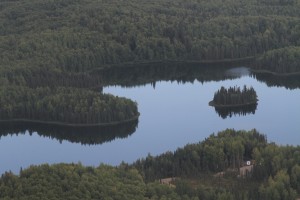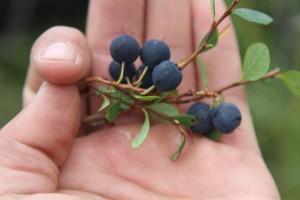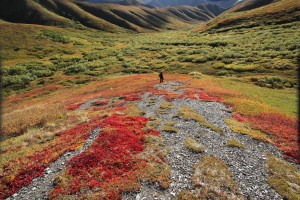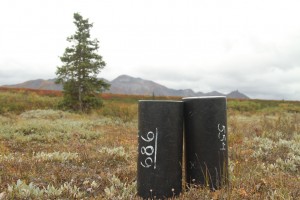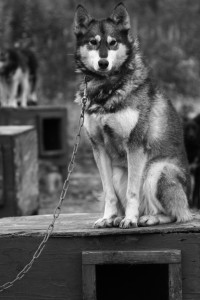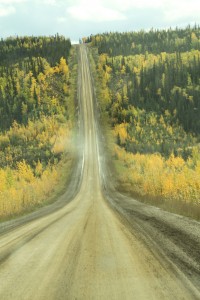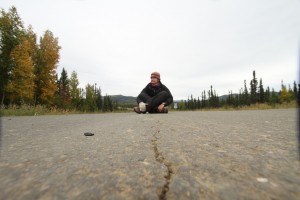Alaska – encounter with a grizzly family, a free flight above taiga and seven days in the wilderness
We are often asked, what countries we like best in our Journey of Life. We seem to pronounce Iran or China quite often. But after Alaska we have to move around our list, as it gets deep down in our brains and veins. It’s wild up there, and for hours and hours you can drive through forests and valleys, and you see no sign of the houses. Before we have left it, we already longed to come back. No wonder why some people come here to visit, but stay for ever. If to close our eyes, we still can picture the bright colours of Dalton road, wild animals, tundra and taiga from above, and we can still taste the red salmon.
Anchorage – a pepper spray against the bears for 50 dollars
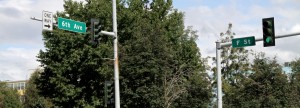
Ko gero pats lengviausias oreantavimąsis mieste. A.. B.. C gatvė.. D.. | I guess the easiest city navigation ever. A.. B.. C street.. D..
To one of the biggest cities in Alaska – if in fact you can talk about big cities at all – we flew from Hawaii. In the airport some stuffed grizzly or albino beaver stand like some beauty and warning – you are entering a wild state. We are soon to enter that wilderness.
As very un-knowledgable people, we come to the visitor centre in Anchorage. Firstly, to get to know more about good places to go and what to do in case we meet some wild animals. We also buy a small book about wild berries, it’s a high time for us to try out a variety of them too. For those who are planning to visit Alaska or north west of Canada, few tips about wild animals.
Secodnly, we desperately need a beer spray. After a long hunt through some shops (‘sorry, we just ran out of it’), we finally get one for 50$. Expensive, but you rather have it…
Animals

Nusileidus Aliaskoje oro uoste mus pasitiko grizlis. Draugiškas. | After landing in Alaska airport a grizzly met us. Friendly one.
In Alaska you most frequently see two sorts of bears distinguished by colours (rarely the white polar bear which inhabits the northern part). Grizzly, or brown bear has a little hump on the back, he is normally bigger than a black bear. The latter one often lives in the forestry area (hence Canada is widely inhabited by them too). Grizzly chooses more open areas, like tundra or near the rivers.
It’s strictly advisable not to run from either of them, as they are predators who will run after they prey. It’s also that you won’t be able to run away from an animal running 50km per hour, who can climb the trees or swim the rivers. Normally if you walk and make lots of noise (talk, laugh, sing), they should run away. If grizzly approaches you, pretend to be big, put your hands up in the air, wave (otherwise you are an elk or so) and shout. They should go away. Otherwise, in case they charge you, you should pretend to be dead. Lay down on the ground, protect the vulnerable areas, leave the backpack on the back. They should see no harm in you and leave.
If the black bear charges you, you will need to fight. Till someone is the winner. Don’t pretend to be dead. It doesn’t work with black ones.
You are highly recommended to have a bear spray with you – it costs 50$, but its a good way to have it ‘just in case’. Usual pepper spray is not strong enough.
In the visitor centre we also bought a book about wild berries for 10$. Brilliant, as we were able to distinguish poisonous from edible ones, and if you in Alaska in August, it would be such a down moment missing out on the berry diversity.
Alaska from above
After having left Anchorage, pretty soon we hitch a humble yet very interesting person. Josh came to live to Alaska, and you might often hear a story something like that ‘I came to visit a friend and stayed here for ever’. He has a log cabin in the wilderness and is a pilot. Very soon he offers us a flight above taiga, mountains. Not only that, we are able to try out some piloting ourselves. This speechless experience is one of our favorite ones. We see the wild rivers from very close, and cross under bridge, go around and over the mountains, around the waterfall, over the forests and little lakes in the sunset.
At the end of our awe experience, Josh takes us to Buyers lake to camp. Even though we come here after the sun is set, he knows that we will be amazed in the morning with a view. And if we dare to try the steep trail to the mountains, we might see even greater views.
We start to walk along the lake. It’s dark. And we are in some sort of the wilderness. The only thought in the head ‘bears’. It would be good to talk aloud, but we run out of topics, even if it was never an issue before. Loud singing is an option, but somewhat the lyrics tend to fade away. The fear taking over. We find a camping place, and there is a container to place all our food. Good, no bears for tonight then.
In the morning we hit the trail. It’s truly spectacular. Up above, when the forests fade and only rocks the place seems like a massive version of Scotland. Only wilder.
On the way down the rain commences, but we still stop for some berries. Blue berries are massive and sweet, and we finally try something new – watermelon berries. We fill our thermos mugs, so we will have oatmeal with berries and honey in the morning.
Denali National Park and Preserve – an encounter with a bear
Denali in local Athabascan language means the High one. They called it the highest peak, which is later been named Mt Mckinley after former senator and later president. It’s huge at 6 million acres, the park is larger than the state of Massachusets. Some local Athabascan groups still live there gathering berries, fishing and hunting, and preserving nature. In fact Denali is preserved so well as it has been hundred years ago. You can encounter caribous, grizzly bears, Doll sheep, wolves and moose, and arctic ground squirrels.
If you want to hike in Denali and camp there, you need to get a backountry permit to do so. It’s free, you only need to tell rangers in which units you are going to camp. The park has around 87 of them, and we chose only 3 of them. The entry fee for the park is 10$ (for 7 days) and the map for some units is 8$. You also receive a plastic container (for free, but you have to return at the end of the hike) to place all your food and cosmetics in there). The green service buses will drop you at your hike starting point, and off you go.
Finally in the wilderness. We soon start our ‘hello!’ and ‘woohoo!’ to scare off the possible animals. Going in the wilderness without tracks means you will need to figure out from the map how to go, where to cross among the mountains or through the rivers. It means you will walk on the soft tundra surface and get tired, or get soaken wet walking through the swamps, or fighting through the bushes. You will find a bear skull or moose antlers. And if you in August you will find tons of blueberries or blackberries, which obviously liked by the bears. That you might guess from the faeces that you will encounter all the way. You know the bear been there.
In the morning we see a moose from afar or a family of caribous. But one encounter struck us completely. The encounter of a grizzly family.
I walk whilst still shouting ‘hey hello’, when all of a sudden see a grizzly sour with two cubs. The little ones look very curious, trying to climb on the mom to see who are those strangers. To see a grizzly is scary enough. To see it from 20 meters is terrifying. To see it with kids – you feel paralyzed, as you know you might be in a big danger. So I see them, and then I see that Karolis doesn’t see them as he has reached the bottom of the tiny valley, and he is going up. ‘Karoli, bears!’. Karolis finds himself a short 20 meter distance from them. They are terribly close. He can hardly take a bear spray from his backpack belt, starts to withdraw slowly, and finally when we both closer to each we start to pretend we are huge. We lift our sticks high above, we wave, we shout. The bear still tries to approach us, then it turns away and walks the other way. Cubs are still trying to look at us curiously. Woof. They are gone. The fear somewhat paralyzes now. They are still ‘sitting in our heads’ for the rest of the day.
Well, only after we got back we got to know, that exactly the same day, one guy first time in Denali been killed by grizzly. It seems he took his chances – he tried to photograph it from far too close and for far too long. The bear took the dead man’s body for cache to keep for food. Grizzly had to be shot down as once he tasted human blood, he would go for more. The first such accident in Denali National Park.
The autumn comes and goes in Alaska as a thunder. Taiga’s leafy plants and trees get the yellowish reddish colours. It’s been a splendid seven day hike.
Fairbanks – one the way to North
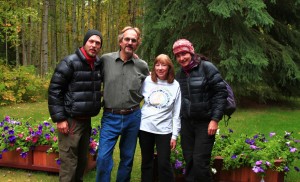
Mus pavežęs ir netikėtai į namus pasivadinęs Fairbanks miestelio gyventojas. | One Fairbanks town resident offered us a place to sleep at his house.
We thought to get a bit more to North, hence Fairbanks could be a good stop for us. Art stops to give us a lift. Soon we realize he is a fair traveller himself, and we have lots to share about. We say bye at the end without exchanging our details. The very next morning, Art finds us on couchsurfing site (as we have talked about it extensively) and invites for a salmon (their family caught the fish by themselves) bbq and dinner and hang out with some locals. We get to know the differences about red and pink salmon, talk about hunting and fishing.
We have some couchsurfing experience in Alaska too. Brenna and David live in a cabin together with 4 dogs and one cat. We eat pancakes with their own produced honey (whilst they put the bees to an eternal sleep later on, as bees cannot survive the winter cold here).
A week later we stay in Art and Anne’s place before will about to go down to Canada. We all refreshed, recharged and ‘salmoned’ (what a taste). But before that we did a northern to detour above the Arctic Circle.
Coldfoot – beyond the Arctic Circle
If you are an independent traveler seeking out to see the Arctic Ocean (reached by the road), you will need to pay 50$ for the tour. Otherwise you might see only Deadhorse or Prudoe Bay towns. So we decided Coldfood was north enough as the weather was a bit dreadfull too.
So we have been given a lift to the crossing where on every site there is forest. Not a living creature out there. No idea, if anyone would pick us up. Corrie and his girlfriend stop for us. He is a cook in Coldfoot, where no one lives, but only a restaurant for the by passers and season visitor centre out there. And only 10 people in the cold winter.
So we visit the Yukon river with a cuppa on the banks of it, and then we reach the Arctic Circle. And when we reach Coldfoot, it’s pouring down. ‘There is a cabin, that no one lives. It’s a bit dusty, but it might be ok for you’. Ok? It was wonderful. We didnt have to get wet down in the tent, it even had a white sheet on the bed (!). So when everyone pays 200$ per night for the stay in the motel-like-cabin, we stay for nought.
And Corrie invites us to hang out with the staff in the evening.
In the evening we also go to listen to the local Heidi Shoppenhurst as she has lots to tell living in the wilderness all year round. Silence and cold in the winter, when the sun doesn’t rise above the horizon for some days, and the rushy times in the summer time, as everyone tries to build the house, to make the jams, to sort everything for the winter. But it’s wild and beautiful out there.
So from Coldfoot through Fairbanks we finally on the way to Canada. ‘You might not be able to hitch for couple days in Tuk one drivers warns us after he invites for a filling lunch. But in no time we hitch Keith, who travels from Alaska down to ‘lower 48′ through Canada. But the canadian adventures soon to come.
Practical tips
Visa
Visa
The same as for Hawaii or any ‘lower 48′. No more than 3 months in Northern America.
Transport
To hitch in Alaska is fairly easy, people are kind. If you intend to hitch up to Prudoe Bay, make sure not to do so in wintertime. People say it’s easier to reach Hilltop cafe – a stop for drivers before a long drive. Only independent truck drivers would take you in, as companies don’t allow passengers on due to insurance etc .

Rengiamės žygiui nepaliestoje gamtoje. Maistas 9 dienoms. Kuprinės svėrė virš 40kg. | Preparing for wildernes. Food for 9 days. Backpacks weighted over 40kg.
Food
If kind locals will host you with red salmon, this is a real meal. It’s absolutely not the same as the pink salmon in cans. Alaska is slightly cheaper than Hawaii, but you need to look what you are buying too. Wallmart is a place to shop if you are a budget traveler, and for those who support a fair business Fred Mayers might be an option.
Hygiene
Alaskan rivers are cold, but to swim in it is a challenge and a reward. Don’t play in it for too long (not that you will be able to) as hypothermia is a very real thing in Alaska. Do not wear cotton or jeans in general, as this will increase the chances of hypothermia as your organism need to waste lots of energy to dry that hard to get dry material.
The water in wild Alaska may look clear, but Giardia and Cryptosporidium, carried by beavers, might present a real health problem, so better drink water treated.
Sleep
Camping is fairly common, but be aware of the wildness. Don’t keep food in your tent, leave it up in the trees or in the containers which bears would not be able to open up.

